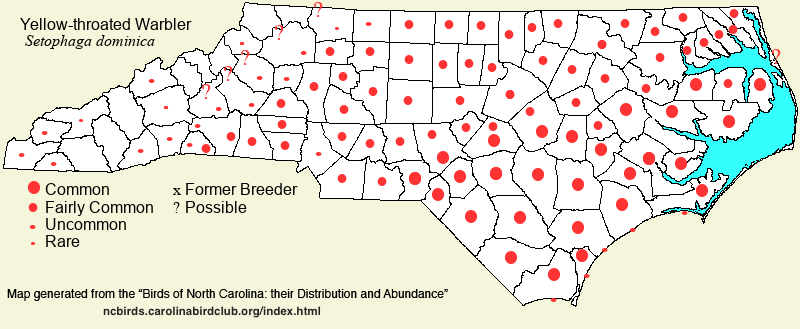 |  |
|
Yellow-throated Warbler - Setophaga dominica PARULIDAE Members: | Search Common: Search Scientific: |
|
|
|||||||
| General Comments | The Yellow-throated Warbler is a "Southern" warbler, as it breeds in the eastern United States only north to southern New York and Iowa and as it is much more common in the Deep South than in the Piedmont and mountains. It even winters in moderate numbers in the southern part of this range, sparingly to North Carolina. With each additional year, more individuals are lingering inland in winter, mainly at feeders. Though it likely nests in all Coastal Plain and Piedmont counties in the state, it is not common in the mountains, where it is limited to the lower elevations. In the breeding season, it favors moist forests and edges, whether in swamps, bottomlands, forests along a lakeshore, streamside groves, or in certain pinelands; forests with scattered tall pines and even Spanish moss are favored. In winter, it is found mainly in maritime forests, or in mature pine-hardwood stands, especially where the hardwoods are broadleaf evergreens. | ||||||
| Breeding Status | Breeder | ||||||
| NC BRC List | Definitive | ||||||
| State Status | |||||||
| U.S. Status | |||||||
| State Rank | S5B | ||||||
| Global Rank | G5 | ||||||
| Coastal Plain | Summer resident, and sparse winter resident near the southern coast. In summer, common over most of the region, more so in the southeastern part of the region than in the northwestern portion. Rare breeder on the Outer Banks. In winter, rare to uncommon, especially scarce by late winter, in the extreme southeastern corner, mainly in New Hanover and Brunswick; present into early winter farther north to the central coast, but rare and does not overwinter. Mainly mid- or late Mar to mid-Oct; arrival dates have been advancing in recent years, and birds are often now present by mid-Mar. A tally of 83 in western Croatan NF was remarkable for the early date of 19 Mar 2016. Peak counts: | ||||||
| Piedmont | Summer resident, and very rare winter straggler. In summer, fairly common to locally common in the eastern and southern portions, uncommon to locally fairly common in the central portion, but quite uncommon in the western/foothill portion, though presumably nests in all counties. Casual as late as Dec and early Jan. A handful of recent midwinter records, including one that overwintered at the Davidson College campus (Mecklenburg), winter 2018-19. Another overwintered (2021-2022) at a feeder in southern Wilkes for the third winter in a row! Another overwintered at a feeder in Cornelius (Mecklenburg) from 6 Jan - 26 Feb 2024. Mainly mid- or late Mar to late Sep. Peak counts: | ||||||
| Mountains | Summer resident. Uncommon along rivers and streams at low elevations, essentially below 2,500 feet; areas with Sycamores are preferred, but it also occurs in some pine stands. Because of this elevation range, it does not breed in a handful of counties, especially in the north (scarce to absent north of Buncombe). However, most unusual and at a moderately high elevation (over 3,200 feet) was an adult seen with two recently fledged juveniles at Valle Crucis (Watauga) on 5 Jul 2023. Nesting was also reported at this same Valle Crucis site in 2024. Scarce migrant, mostly at lower elevations. Mainly early Apr to mid-Sep. Peak counts: | ||||||
| Finding Tips |
The species is easily found in many parks and preserves, and Croatan National Forest, in the southeastern part of the Coastal Plain, as well as along Sandhills streams. **** | ||||||
| Attribution | LeGrand[2024-11-11], LeGrand[2024-05-15], LeGrand[2023-10-20] | ||||||
| NC Map Map depicts all counties with a report (transient or resident) for the species. | Click on county for list of all known species. |
| NC Breeding Season Map Map depicts assumed breeding season abundance for the species. |  |